Consumer Attitudes and Preferences towards Traditional Food Products in Vojvodina
Abstract
:1. Introduction
2. Literature Review
2.1. Consumer Attitudes and Preferences
2.2. Traditional Food Products
2.3. Quality Schemes and Certification
2.4. Specially Labeled Food Products
3. Research Methodology
3.1. Research Objective and Hypothesis
3.2. Research Methods and Questionnaire
3.3. Statistical Analyses
4. Results
4.1. Socio-Demographic Characteristics of Respondents
4.2. Consumer Preference and Attitudes towards Traditional Food Products
5. Discussion and Conclusions
Author Contributions
Funding
Institutional Review Board Statement
Informed Consent Statement
Data Availability Statement
Acknowledgments
Conflicts of Interest
References
- Scholliers, P. Food, Drink and Identity: Cooking, Eating and Drinking in Europe Since the Middle Ages; Berg Publishers: Oxford, UK, 2001. [Google Scholar]
- European Commission. European Research on Traditional Food. Website. 2007. Available online: ftp://ftp.cordis.europa.eu/pub/fp7/kbbe/docs/traditional-foods.pdf (accessed on 14 June 2023).
- Trichopoulou, A.; Soukara, S.; Vasilopoulou, E. Traditional foods: A science and society perspective. Trends Food Sci. Tech. 2007, 18, 420–427. [Google Scholar] [CrossRef]
- Ikonić, P.; Peulić, T.; Delić, J.; Novaković, A.; Dapcevic-Hadnadjev, T.; Skrobot, D. Quality standardization and certification of traditional food products. In IOP Conference Series: Earth and Environmental Science, Proceedings of the 61st International Meat Industry Conference, Zlatibor, Serbia, 26–29 September 2021; IOP Publishing: Bristol, UK, 2021; Volume 854, p. 012035. [Google Scholar]
- Jia, Z.; Zhang, B.; Sharma, A.; Kim, N.S.; Purohit, S.M.; Green, M.M.; Roche, M.R.; Holliday, E.; Chen, H. Revelation of the sciences of traditional foods. Food Control 2023, 145, 109392. [Google Scholar] [CrossRef]
- Feldmann, C.; Hamm, U. Consumers’ perceptions and preferences for local food: A review. Food Qual. Prefer. 2015, 40, 152–164. [Google Scholar] [CrossRef]
- Kovács, I.; Balázsné Lendvai, M.; Beke, J. The Importance of Food Attributes and Motivational Factors for Purchasing Local Food Products: Segmentation of Young Local Food Consumers in Hungary. Sustainability 2022, 14, 3224. [Google Scholar] [CrossRef]
- Guerrero, L.; Dolors Guàrdia, M.; Xicola, J.; Verbeke, W.; Vanhonacker, F.; Zakowska-Biemans, S.; Sajdakowska, M.; Sulmont-Rossé, C.; Issanchou, S.; Contel, M.; et al. Consumer-driven definition of traditional food products and innovation in traditional foods. A qualitative cross-cultural study. Appetite 2009, 52, 345–354. [Google Scholar] [CrossRef]
- Dansero, E.; Puttilli, M. Multiple territorialities of alternative food networks: Six cases from Piedmont, Italy. Local Environ. Int. J. Justice Sustain. 2013, 19, 626–643. [Google Scholar] [CrossRef]
- Fernández-Ferrína, P.; Calvo-Turrientes, A.; Bande, B.; Artaraz-Miñón, M.; Galán-Ladero, M. The valuation and purchase of food products that combine local, regional and traditional features: The influence of consumer ethnocentrism. Food Qual. Prefer. 2018, 64, 138–147. [Google Scholar] [CrossRef]
- Haddad, L.; Hawkes, C.; Waage, J.; Webb, P.; Godfray, C.; Toulmin, C. Food Systems and Diets: Facing the Challenges of the 21st Century; Global Panel on Agriculture and Food Systems for Nutrition: London, UK, 2016. [Google Scholar]
- Moscatelli, S.; Gamboni, M.; Dernini, S.; Capone, R.; El Bilali, H.; Bottalico, F.; Debs, P.; Cardone, G. Exploring the socio-cultural sustainability of traditional and typical agro-food products: Case study of Apulia Region, South-eastern Italy. J. Food Nutr. Res. 2017, 5, 6–14. [Google Scholar]
- Cerjak, M.; Haas, R.; Brunner, F.; Tomic, M. What motivates consumers to buy traditional food products? Evidence from Croatia and Austria using word association and laddering interviews. Br. Food J. 2014, 116, 1726–1747. [Google Scholar] [CrossRef]
- Mintel Group. Food and Drink Trends. 2018. Available online: https://gastronomiaycia.republica.com/wp-content/uploads/2017/10/informe_mintel_tendencias_2018.pdf (accessed on 14 June 2023).
- Rocillo-Aquino, Z.; Cervantes-Escoto, F.; Leos-Rodríguez, J.A.; Cruz-Delgado, D.; Espinoza-Ortega, A. What is a traditional food? Conceptual evolution from four dimensions. J. Ethn. Food 2021, 8, 38. [Google Scholar] [CrossRef]
- Byrne, D.V.; Waehrens, S.S.; O’Sullivan, M.G. Future development, innovation and promotion of European unique food: An interdisciplinary research framework perspective. J. Sci. Food Agric. 2013, 93, 3414–3419. [Google Scholar] [CrossRef]
- Donati, M.; Wilkinson, A.; Veneziani, M.; Antonioli, F.; Arfini, F.; Bodini, A.; Amilien, V.; Csillag, P.; Ferrer-Pérez, H.; Gkatsikos, A.; et al. Economic spill-over of food quality schemes on their territory. J. Agric. Food Ind. Organ. 2021, 19, 95–111. [Google Scholar] [CrossRef]
- European Green Deal, the Economic, Social and Environmental Sustainability, a Priority for the PDO PGI Supply Chains. Available online: http://www.lifettgg.eu/en/2020/12/16/the-economic-social-and-environmental-sustainability-a-priorityfor-the-pdo-pgi-supply-chains/ (accessed on 23 September 2021).
- Chifor, C.; Arion, I.D.; Isarie, V.I.; Arion, F.H. A Systematic Literature Review on European Food Quality Schemes in Romania. Sustainability 2022, 14, 16176. [Google Scholar] [CrossRef]
- De Canio, F.; Martinelli, E. EU Quality Label vs. Organic Food Products: A Multigroup Structural Equation Modeling to Assess Consumers’ Intention to Buy in Light of Sustainable Motives. Food Res. Int. 2021, 139, 109846. [Google Scholar] [CrossRef]
- UNIDO 2010 Adding Value to Traditional Products of Regional Origin: A Guide to Creating a Quality Consortium Business, Investment and Technology Services Branch; Technical Paper Series; UNIDO: Vienna, Austria, 2010.
- Barska, A.; Wojciechowska-Solis, J. Traditional and Regional Food as Seen by Consumers–Research Results: The Case of Poland. Br. Food J. 2018, 120, 1994–2004. [Google Scholar] [CrossRef]
- Alexandra-Ioana, G.; Dabija, D.C.; Fiore, M.; Bianca Pocol, C. Consumer Perception and Understanding of European Union Quality Schemes: A Systematic Literature Review. Sustainability 2022, 14, 1667. [Google Scholar] [CrossRef]
- Tasić, T.; Ikonić, P.; Jokanović, M.; Mandić, A.; Tomovic, V.; Šojić, B.; Škaljac, S. Content of vasoactive amines in Sremski kulen and Sremska kobasica traditional dry fermented sausages from Vojvodina. Procedia Food Sci. 2015, 5, 282–284. [Google Scholar] [CrossRef]
- Kalenjuk Pivarski, B.; Šmugović, S.; Tekić, D.; Ivanović, V.; Novaković, A.; Tešanović, D.; Banjac, M.; Ðerčan, B.; Peulić, T.; Mutavdžić, B.; et al. Characteristics of Traditional Food Products as a Segment of Sustainable Consumption in Vojvodina’s Hospitality Industry. Sustainability 2022, 14, 13553. [Google Scholar] [CrossRef]
- Kalenjuk Pivarski, B.; Tekić, D.; Šmugović, S.; Banjac, M.; Novaković, A.; Mutavdžić, B.; Ivanović, V.; Tešanović, D.; Đerčan, B.; Ikonić, P.; et al. Factors Affecting the Consumption of Traditional Food in Tourism—Perceptions of the Management Sector of Catering Facilities. Foods 2023, 12, 2338. [Google Scholar] [CrossRef]
- Tremma, O.; Kontogeorgos, A.; Karipidis, P.; Chatzitheodoridis, F. Mapping the Market Segments for the Consumers of Greek Cooperative Food Products. Sustainability 2021, 13, 3825. [Google Scholar] [CrossRef]
- Merlino, V.M.; Sciullo, A.; Pettenati, G.; Sottile, F.; Peano, C.; Massaglia, S. Local Production”: What Do Consumers Think? Sustainability 2022, 14, 3623. [Google Scholar] [CrossRef]
- Fandos-Herrera, C. Exploring the Mediating Role of Trust in Food Products with Protected Designation of Origin. The Case of ‘Jamón de Teruel’. Span. J. Agric. Res. 2016, 14, e0102. [Google Scholar] [CrossRef]
- Prakash, V. Introduction: The Importance of Traditional and Ethnic Food in the Context of Food Safety, Harmonization, and Regulations. In Regulating Safety of Traditional and Ethnic Foods; Prakash, V., Martín-Belloso, O., Keener, L., Astley, S., Braun, S., McMahon, H., Lelieveld, H., Eds.; Academic Press: Waltham, MA, USA, 2016; pp. 1–6. ISBN 978-012-800-605-4. [Google Scholar]
- Belletti, G.; Marescotti, A.; Touzard, J.-M. Geographical Indications, Public Goods, and Sustainable Development: The Roles of Actors’ Strategies and Public Policies. World Dev. 2017, 98, 45–57. [Google Scholar] [CrossRef]
- Popkin, B.M.; Hawkes, C. Sweetening of the global diet, particularly beverages: Patterns, trends, and policy responses. Lancet Diabetes Endocrinol. 2016, 4, 174–186. [Google Scholar] [CrossRef] [PubMed]
- WHO. Sugars Intake for Adults and Children-Guideline. 2015. Available online: http://www.who.int/nutrition/publications/guidelines/sugars_intake/en/ (accessed on 16 April 2016).
- Mooradian, A.D.; Smith, M.; Tokuda, M. The role of artificial and natural sweeteners in reducing the consumption of table sugar: A narrative review. Clinl. Nutr. ESPEN 2017, 18, 1–8. [Google Scholar] [CrossRef]
- Azaïs-Braesco, V.; Sluik, D.; Maillot, M.; Kok, F.; Moreno, L.A. A review of total & added sugar intakes and dietary sources in Europe. Nutr. J. 2017, 16, 6. [Google Scholar] [CrossRef]
- Scapin, T.; Fernandes, A.C.; Proença, R.P.C. Added sugars: Definitions, classifications, metabolism and health implications. J. Nutr. 2017, 30, 663–677. [Google Scholar] [CrossRef]
- Health Canada. History of Canada’s Food Guides from 1942 to 2007. 2019. Available online: https://www.canada.ca/en/health-canada/services/canada-food-guide/about/history-food-guide.html (accessed on 14 June 2023).
- Available online: https://www.slowfood.com/ (accessed on 14 June 2023).
- Schneider, S. Good, clean, fair: The rhetoric of the slow food movement. Coll. Engl. 2008, 70, 384–402. [Google Scholar]
- Irianto, H. Consumers’ attitude and intention towards organic food purchase: An extension of theory of planned behavior in gender perspective. Int. J. Manage Econ. Soc. Sci. 2015, 4, 17–31. [Google Scholar]
- Saulais, L.; Corcuff, R.; Boonefaes, E. Natural and healthy? Consumers knowledge, understanding and preferences regarding naturalness and healthiness of processed foods. Int. J. Gastron. Food Sci. 2023, 31, 100662. [Google Scholar] [CrossRef]
- Lu Hsu, J.; Sung, C.C.; Tseng, J.T. Willingness-to-pay for ready-to-eat clean label food products at convenient stores. Future Foods 2023, 7, 100237. [Google Scholar] [CrossRef]
- Falguera, V.; Aliguer, N.; Falguera, M. An integrated approach to current trends in food consumption: Moving toward functional and organic products? Food Control 2012, 26, 274–281. [Google Scholar] [CrossRef]
- Hartmann, M.; Yeh, C.-H.; Amilien, V.; Čeliković, Z.; Csillag, P.; Filipović, J.; Giraud, G.; Gorton, M.; Kuč, V.; Menozzi, D.; et al. Report on Quantitative Research Findings on European Consumers’ Perception and Valuation of EU Food Quality Schemes as well as Their Confidence in Such Measures; Strength2Food: Paris, France, 2019. [Google Scholar]
- Ingredion. The Clean Label Guide to Europe; Ingredion: Westchester, NY, USA, 2014. [Google Scholar]
- Maruyama, S.; Streletskaya, N.A.; Lim, J. Clean label: Why this ingredient but not that one? Food Qual. Prefer. 2021, 87, 104062. [Google Scholar]
- Asioli, D.; Aschemann-Witzel, J.; Caputo, V.; Vecchio, R.; Annunziata, A.; Naes, T.; Varela, P. Making sense of the “clean label” trends: A review of consumer food choice behavior and discussion of industry implications. Food Res. Int. 2017, 99, 58–71. [Google Scholar] [CrossRef]
- Verain, M.C.D.; Sijtsema, S.J.; Antonides, G. Consumer segmentation based on food-category attribute importance: The relation with healthiness and sustainability perceptions. Food Qual. Prefer. 2016, 48, 99–106. [Google Scholar] [CrossRef]
- Cargill. Transparency and Simplicity: The New Normal in Product Development; Cargill Proprietary Research White Paper; Cargill: Minnetonka, MN, USA, 2017. [Google Scholar]
- Euromonitor International. Megatrend Analysis: Putting the Consumer at the Heart of Business. 2017. Available online: http://go.euromonitor.com/white-paper-2017-megatrend-analysis.html (accessed on 14 June 2023).
- Bostan, I.; Onofrei, M.; Gavriluţă, A.F.; Toderaşcu, C.; Lazăr, C.M. An integrated approach to current trends in organic food in the EU. Foods 2019, 8, 144. [Google Scholar] [CrossRef]
- Grappe, C.G.; Lombart, C.; Louis, D.; Durif, F. Clean labeling: Is it about the presence of benefits or the absence of detriments? Consumer response to personal care claims. J. Retail. Consum. Ser. 2022, 65, 102893. [Google Scholar] [CrossRef]
- Inguglia, E.S.; Song, Z.; Kerry, J.P.; O’Sullivan, M.G.; Hamill, R.M. Addressing Clean Label Trends in Commercial Meat Processing: Strategies, Challenges and Insights from Consumer Perspectives. Foods 2023, 12, 2062. [Google Scholar] [CrossRef]
- Chaniotakis, I.E.; Lymperopoulos, C.; Soureli, M. Consumers’ intentions of buying own-label premium food products. J. Prod. Brand. Manag. 2010, 19, 327–334. [Google Scholar] [CrossRef]
- Sogari, G.; Pucci, T.; Caputo, V.; Van Loo, E.J. The theory of planned behaviour and healthy diet: Examining the mediating effect of traditional food. Food Qual. Prefer. 2023, 104, 104709. [Google Scholar] [CrossRef]
- Stanojević, S.; Pešić, M.; Milinčić, D.; Kostić, A.; Pešić, M. Nutritional behavior and motives of college students for the choice of traditional food in the Republic of Serbia. Heliyon 2022, 8, e11002. [Google Scholar] [CrossRef] [PubMed]
- Jordana, J. Traditional foods: Challenges facing the European food industry. Food Res. Int. 2000, 33, 147–152. [Google Scholar] [CrossRef]
- Weichselbaum, D.E.; Benelam, B.; Costa, H.S. Synthesis Report No. 6: Traditional Foods in Europe. 2009. Available online: https://www.eurofir.org/wp-admin/wp-content/uploads/EuroFIR%20synthesis%20reports/Synthesis%20Report%206_Traditional%20Foods%20in%20Europe.pdf (accessed on 14 June 2023).
- Cavicchi, A.; Santini, C. Case Studies in the Traditional Food Sector: A Volume in the Consumer Science and Strategic Marketing Series; Woodhead Publishing: Cambridge, UK, 2017. [Google Scholar]
- Caputo, V.; Sacchi, G.; Lagoudakis, A. Traditional Food Products and Consumer Choices: A Review. In Case Studies in the Traditional Food Sector; Cavicchi, A., Santini, C., Eds.; Woodhead Publishing: Cambridge, UK, 2018; pp. 47–87. [Google Scholar] [CrossRef]
- EU. Council Regulation (EC) No 509/2006 of 20 March 2006 on agricultural products and foodstuffs as traditional specialities guaranteed. Off. J. Eur. Union. 2006, 31, 3. [Google Scholar]
- Oliveira, J.; Kristbergsson, K. Traditional Foods: General and Consumer Aspects; Springer: Berlin/Heidelberg, Germany, 2016. [Google Scholar]
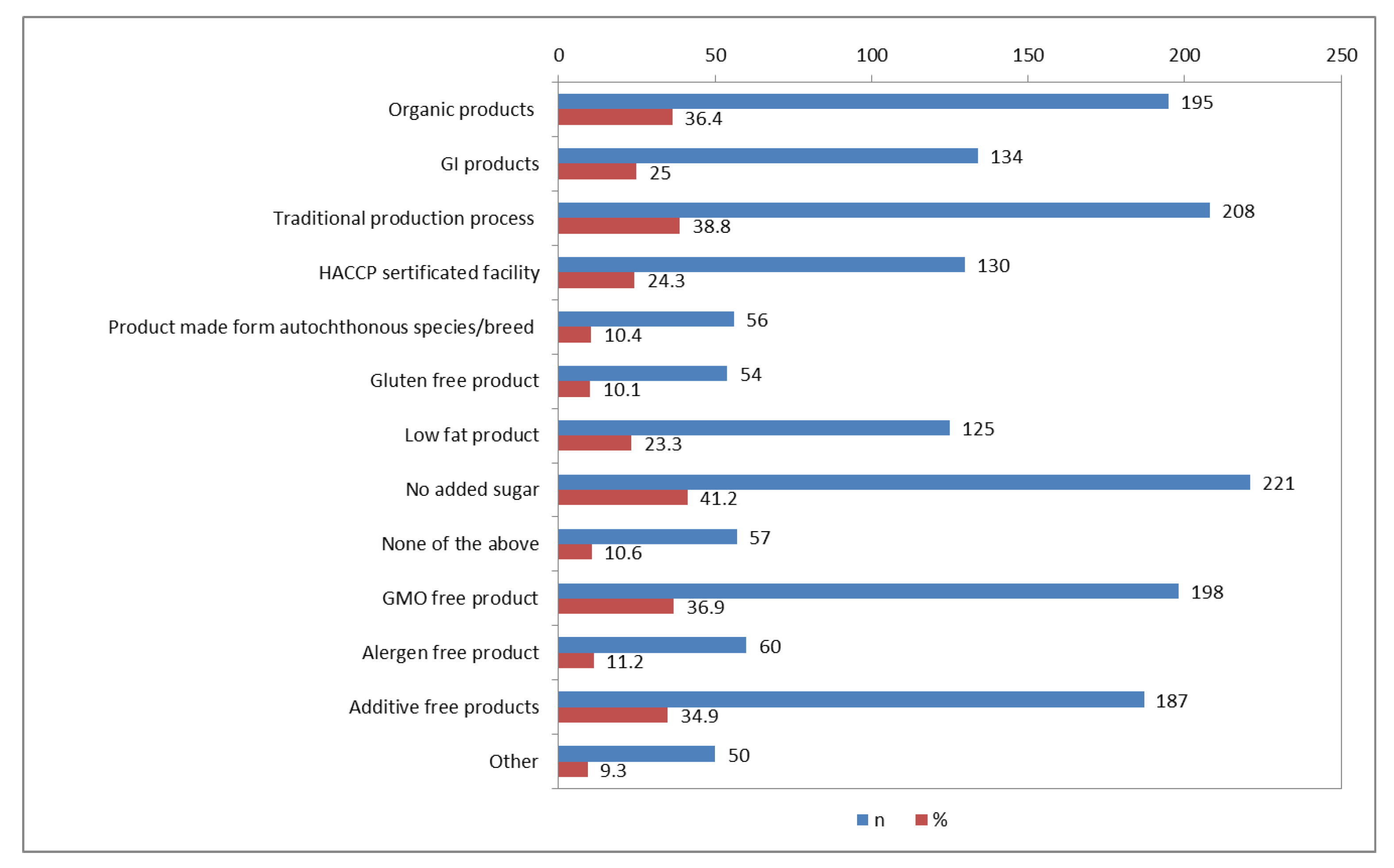
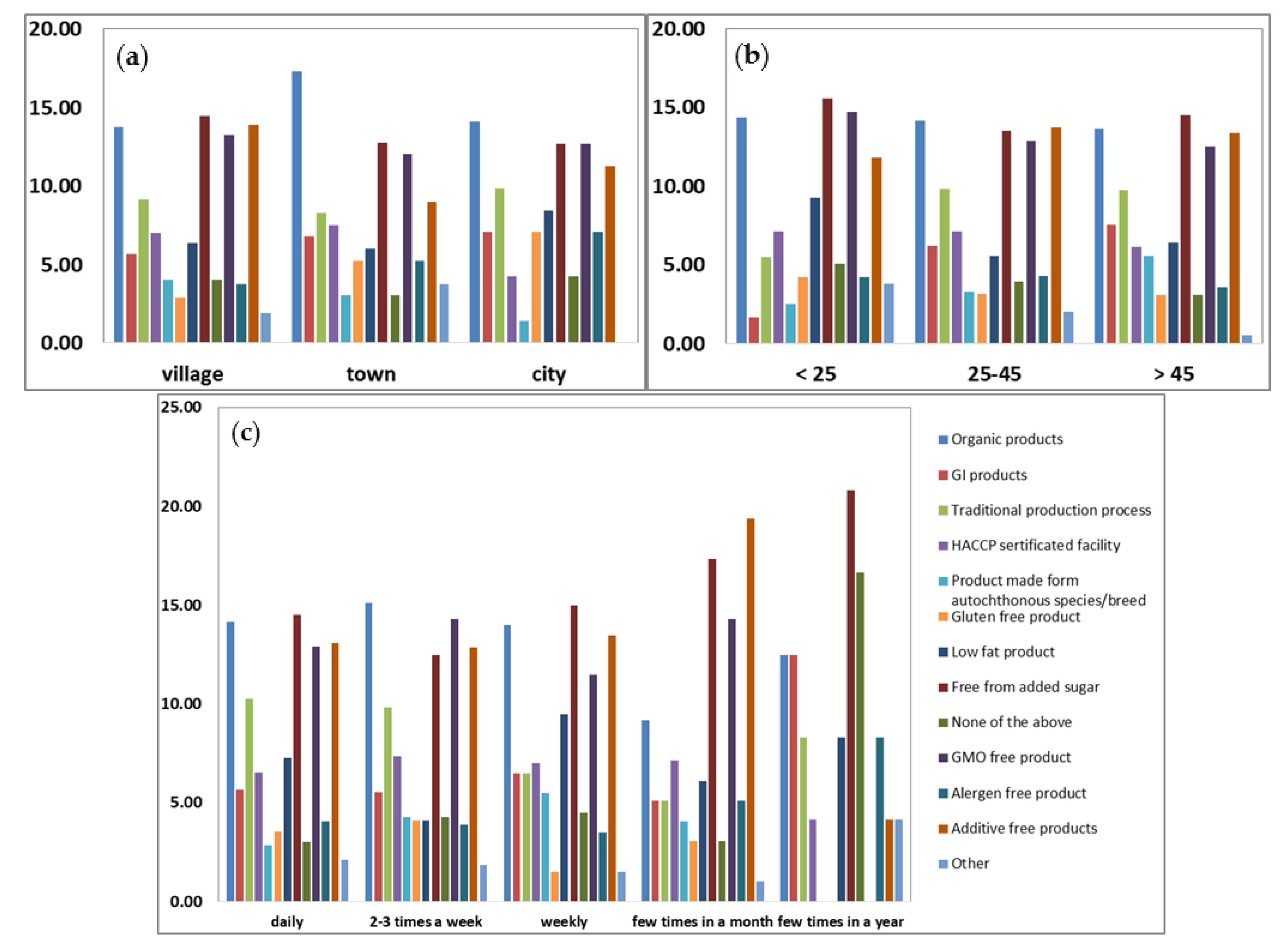
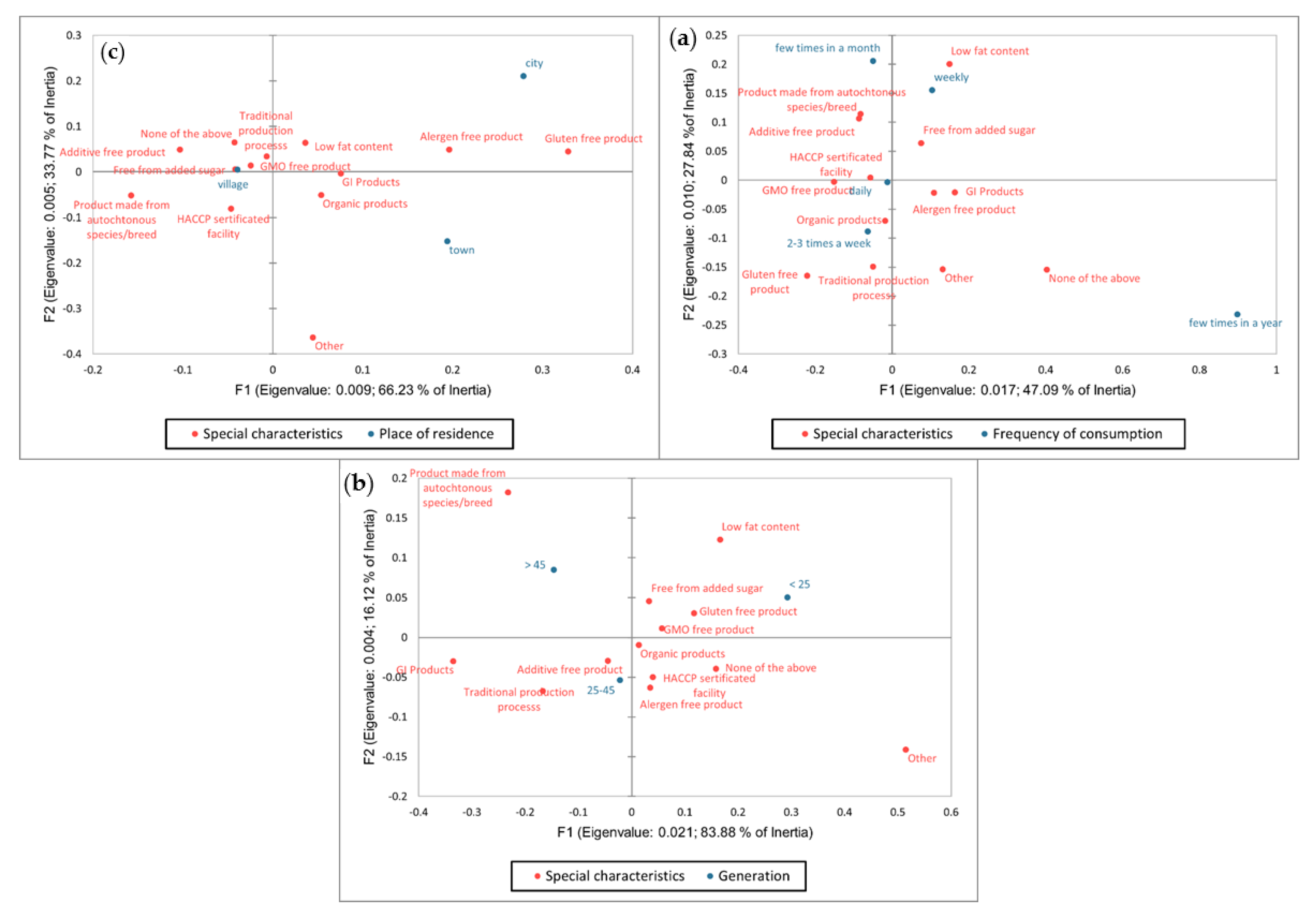


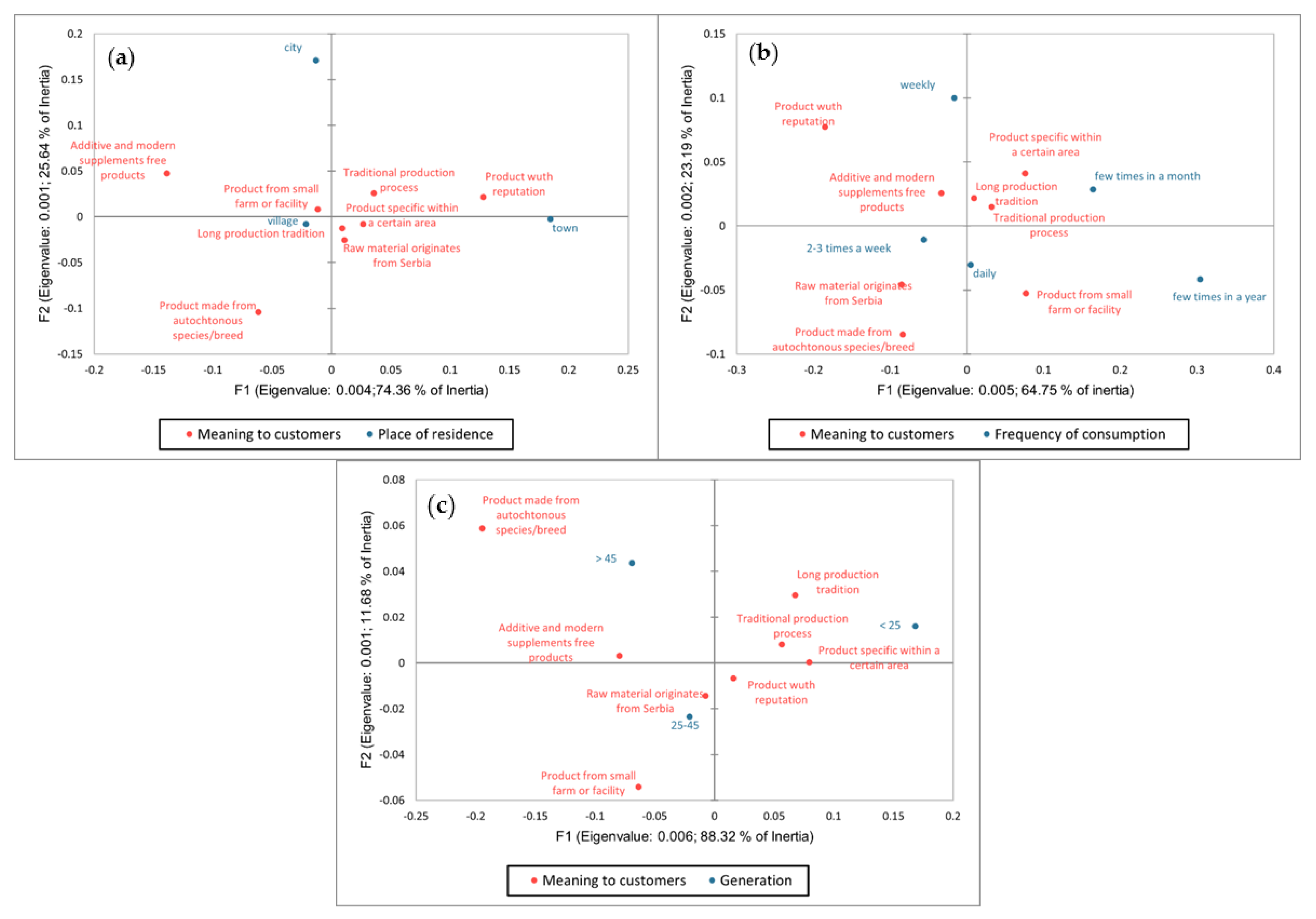
| Socio-Demographic Characteristics | Whole Sample | ||
|---|---|---|---|
| n | Percentage | ||
| Gender | female | 373 | 69.1 |
| male | 167 | 30.9 | |
| Age | <25 | 140 | 25.9 |
| 25–45 | 300 | 55.6 | |
| >45 | 100 | 18.5 | |
| Place of residence | village | 55 | 10.2 |
| town | 26 | 4.8 | |
| city | 459 | 85 | |
| Employment | student | 95 | 17.6 |
| employed | 380 | 70.4 | |
| unemployed | 25 | 4.6 | |
| pensioner | 40 | 7.4 | |
| Monthly income (EUR) | <425 | 55 | 10.2 |
| 425–850 | 170 | 31.7 | |
| 850–1275 | 124 | 23.1 | |
| >1275 | 188 | 35 | |
| Members in households | 1 | 62 | 11.5 |
| 2 | 124 | 23 | |
| 3 or more | 354 | 65.6 | |
| Question | Answer | Whole Sample | |
|---|---|---|---|
| n | Percentage | ||
| Are traditional food products consumed in your household? | yes | 531 | 98.3 |
| no | 9 | 1.7 | |
| How often are traditional food products consumed in your household? | daily | 209 | 38.7 |
| 2–3 times a week | 187 | 34.6 | |
| weekly | 85 | 15.8 | |
| few times in a month | 44 | 8.1 | |
| few times in a year | 13 | 2.4 | |
| not consumed | 2 | 0.4 | |
| Are your purchase decisions for food products based on quality? | yes | 514 | 95.2 |
| no | 26 | 4.8 | |
| Do you prefer to buy certified food products? | yes | 239 | 44.2 |
| from time to time | 211 | 39.1 | |
| not sure | 56 | 10.4 | |
| no | 34 | 6.3 | |
| Do you think that certain types of certification can improve product placement on the market? | yes | 368 | 68.2 |
| not sure | 139 | 25.7 | |
| no | 33 | 6.1 | |
| Title 1 | 1 | 2 | 3 | 4 | 5 | ||
|---|---|---|---|---|---|---|---|
| 1. | I am satisfied with traditional food products offered on the market | n | 16 | 68 | 256 | 138 | 62 |
| % | 3 | 12.6 | 47.4 | 25.6 | 11.5 | ||
| 2. | I am satisfied with the quality of traditional food products on the market | n | 13 | 41 | 196 | 211 | 80 |
| % | 2.4 | 7.6 | 36.2 | 39 | 14.8 | ||
| 3. | I believe that the higher price of traditional food products is related to their quality | n | 11 | 50 | 156 | 215 | 108 |
| % | 2 | 9.3 | 28.9 | 39.8 | 20 | ||
| 4. | Traditional food products are available and easy to purchase | n | 23 | 89 | 230 | 152 | 47 |
| % | 4.3 | 16.5 | 42.5 | 28.1 | 8.7 | ||
| 5. | I prefer traditional food products over conventional ones | n | 11 | 24 | 123 | 162 | 218 |
| % | 2 | 4.5 | 22.9 | 30.1 | 40.5 | ||
| 6. | I prefer local traditional food products over foreign ones | n | 11 | 20 | 82 | 126 | 299 |
| % | 2 | 3.7 | 15.2 | 23.4 | 55.6 | ||
| 7. | I prefer products that have a certain mark of quality assurance | n | 27 | 20 | 149 | 168 | 174 |
| % | 5 | 3.7 | 27.7 | 31.2 | 32.3 | ||
| 8. | In catering establishments, I usually choose traditional food products or dishes made from traditional food products | n | 18 | 38 | 164 | 165 | 154 |
| % | 3.3 | 7.1 | 30.4 | 30.6 | 28.6 | ||
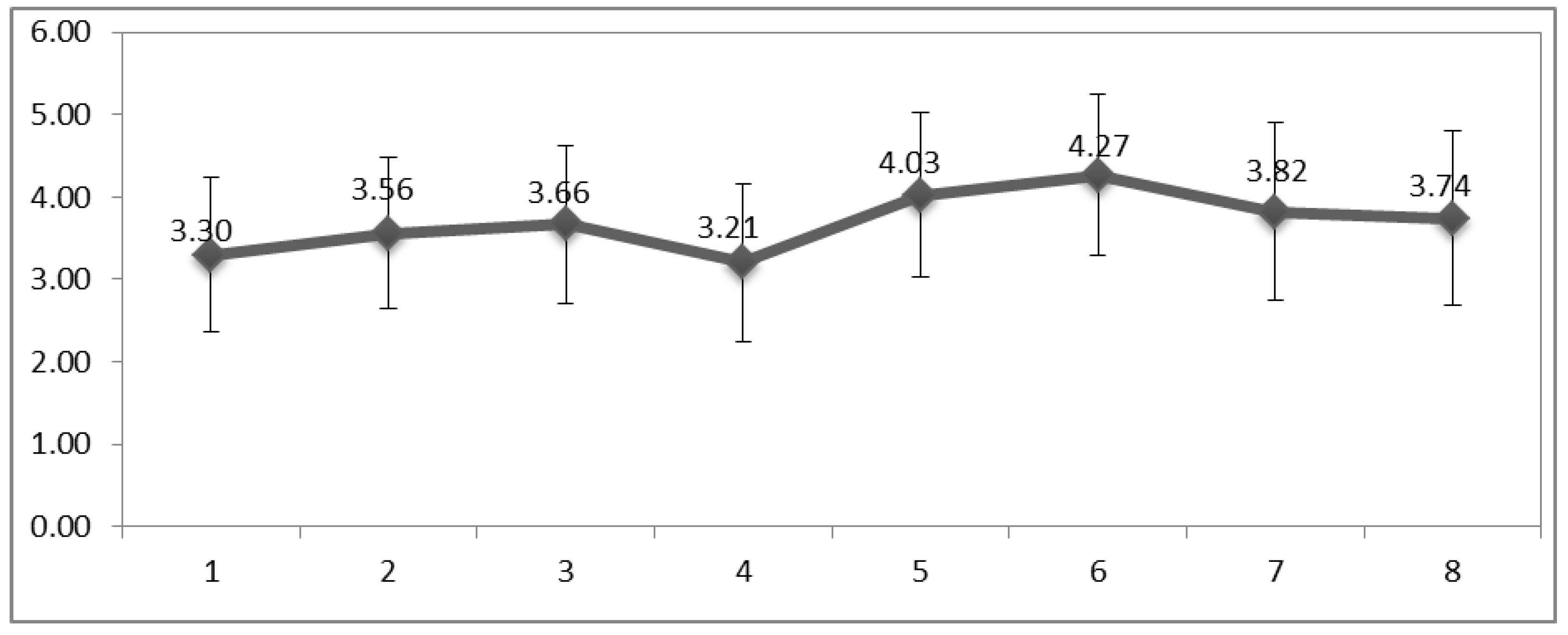 | |||||||
Disclaimer/Publisher’s Note: The statements, opinions and data contained in all publications are solely those of the individual author(s) and contributor(s) and not of MDPI and/or the editor(s). MDPI and/or the editor(s) disclaim responsibility for any injury to people or property resulting from any ideas, methods, instructions or products referred to in the content. |
© 2023 by the authors. Licensee MDPI, Basel, Switzerland. This article is an open access article distributed under the terms and conditions of the Creative Commons Attribution (CC BY) license (https://creativecommons.org/licenses/by/4.0/).
Share and Cite
Peulić, T.; Marić, A.; Maravić, N.; Novaković, A.; Kalenjuk Pivarski, B.; Čabarkapa, I.; Lazarević, J.; Šmugović, S.; Ikonić, P. Consumer Attitudes and Preferences towards Traditional Food Products in Vojvodina. Sustainability 2023, 15, 12420. https://doi.org/10.3390/su151612420
Peulić T, Marić A, Maravić N, Novaković A, Kalenjuk Pivarski B, Čabarkapa I, Lazarević J, Šmugović S, Ikonić P. Consumer Attitudes and Preferences towards Traditional Food Products in Vojvodina. Sustainability. 2023; 15(16):12420. https://doi.org/10.3390/su151612420
Chicago/Turabian StylePeulić, Tatjana, Aleksandar Marić, Nikola Maravić, Aleksandra Novaković, Bojana Kalenjuk Pivarski, Ivana Čabarkapa, Jasmina Lazarević, Stefan Šmugović, and Predrag Ikonić. 2023. "Consumer Attitudes and Preferences towards Traditional Food Products in Vojvodina" Sustainability 15, no. 16: 12420. https://doi.org/10.3390/su151612420
APA StylePeulić, T., Marić, A., Maravić, N., Novaković, A., Kalenjuk Pivarski, B., Čabarkapa, I., Lazarević, J., Šmugović, S., & Ikonić, P. (2023). Consumer Attitudes and Preferences towards Traditional Food Products in Vojvodina. Sustainability, 15(16), 12420. https://doi.org/10.3390/su151612420











